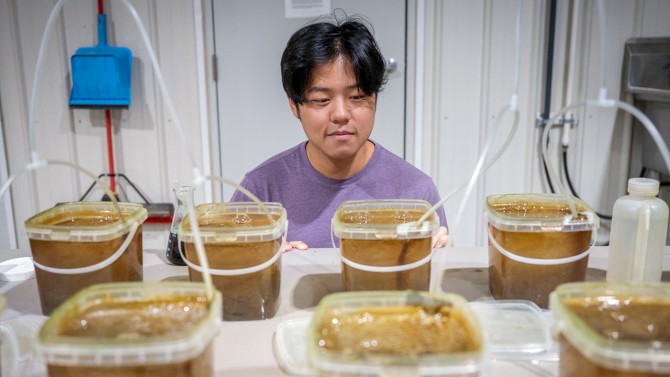
From aboard a Cornell Biological Field Station boat, Logan Lee collected mussels and mayfly larvae at Oneida Lake for his summer research.
Mussels helping mayflies flex in return to Oneida Lake
By Blaine Friedlander, Cornell Chronicle
Quagga mussels – the deleterious invasive species from Eastern Europe seen throughout Oneida Lake – may provide an unexpected benefit for the life cycle of mayflies.
A food source for fish, mayflies are currently experiencing a renaissance on the lake, which is northeast of Syracuse. The water-borne insects had all but disappeared some 60 years ago, but the mayfly population now flourishes, pleasing the palates of walleye, perch and smallmouth bass.
Cornell scientists want to know why.
Research intern Logan Lee ’27 at the Cornell Biological Field Station at Shackelton Point, New York, and his mentor, Thomas Evans, research associate in the Department of Natural Resources and the Environment in the College of Agriculture and Life Sciences (CALS), theorize that while these small quagga mussels disrupt the ecology of Oneida Lake, they are placing nutrients directly into the lake’s sediment – the mayfly larvae nursery.
“Before I got here, I didn’t know about mayflies,” said Lee, a biological engineering major (CALS). “Of course, I knew their name, but I had never seen one or had spent time around a lake.”
Lee understands the bugs now. Mayflies start as larval nymphs that burrow into the lake sediment. As they grow into short-lived adults, mayflies emerge from the water, shed their skin and hover near the lake looking to mate. After they rise, the lake’s fish consume them.
The fortunate female mayflies who manage to avoid becoming fish food deposit thousands of eggs onto the water. These eggs burrow into the sediment and stay there for up to two years, after which the cycle restarts.
Swarms of the adult bugs surfaced again in late June. “There’s been a big reemergence, a big uptick in mayflies coming out,” Lee said. “You see big clumps of them on the water, floating along the shoreline in giant piles.”
When summer started, Lee trolled the lake aboard the Cornell station’s boat, collecting the quagga mussels and mayfly nymphs for his research.
Interning means thinking like a scientist: When Lee dug up the muddy lake bottom, he sought smaller larvae. “I chose them for my research to be a certain size, small, so that the larvae wouldn’t emerge as adults during the span of my work,” he said. “Otherwise, that would mean losing points of data.”
Tending to aquatic life is not new to Lee. He served on the Aquaculture project team for Cornell University Sustainable Design group and is helping to develop an automated feeding system for tilapia to minimize food waste.
In his daily summer routine, Lee cares for more than 300 quagga mussels and 48 mayfly larvae in plastic containers. Like caring for a loving pet, he feeds the mussels a daily diet of algae and yeast, while the insect larvae relish the waste.
Lee will measure the larvae in August to gauge how the number of mussels in the plastic cups supplied nutrients and affected larval nymph growth.
Since the invasion of the mussels, the shallow and once-murky 80-square-mile Oneida Lake – which previously teemed with nutritious organic matter – now has clarified water.
“Mussels may be one of the reasons mayflies suddenly have done so well. There’s food,” said Evans, the mentoring aquatic ecologist. “Mussels – in their processed waste – seem to be providing a natural, constant smorgasbord for mayflies in the sediment.”
Evans notes the irony of a disturbing species. “It’s counterintuitive, because when we think of quagga mussels, we think of them as having a strong, negative environmental impact and there’s no question about it,” he said. “But quaggas can change the lake’s ecology to be like the past. It’s nuanced. It’s challenging. There seem to be lot of layers here.”
Each summer, the Cornell Biological Field Station – in place since the mid-1950s – hosts about 10 Cornell undergraduate interns who get hands-on research experience with professors and scientists on an array of projects. It is managed through the Department of Natural Resources and the Environment, in partnership with Cornell Cooperative Extension. Their work produces published papers and honors theses.
Lee’s experience with mussels and mayflies has fortified his scientific exploration experience.
“It’s cool to see all the people with so much experience working at Oneida Lake, just knowing everything about it,” said Lee, whose internship is funded by the U.S. Environmental Protection Agency’s National Great Lakes Program Office. “The environmental research is part of that big puzzle – that is the lake. It is fascinating to see how much one lake can be studied.”
Media Contact
Get Cornell news delivered right to your inbox.
Subscribe



